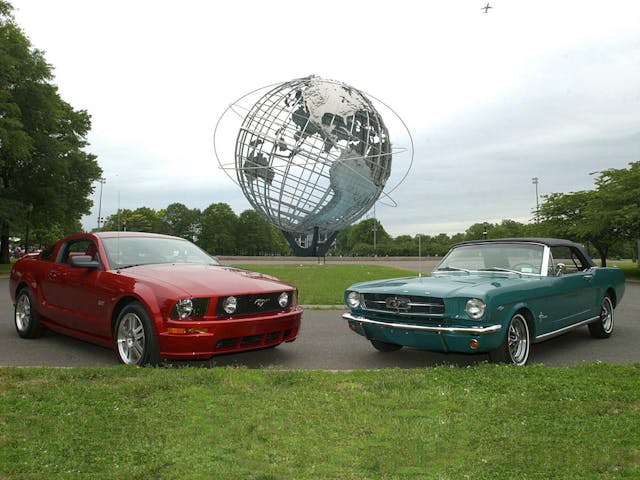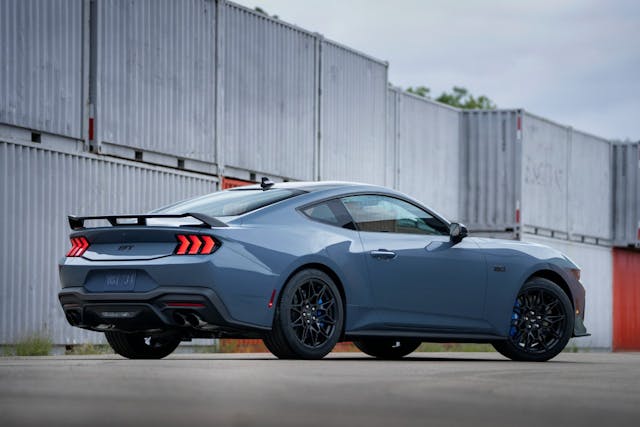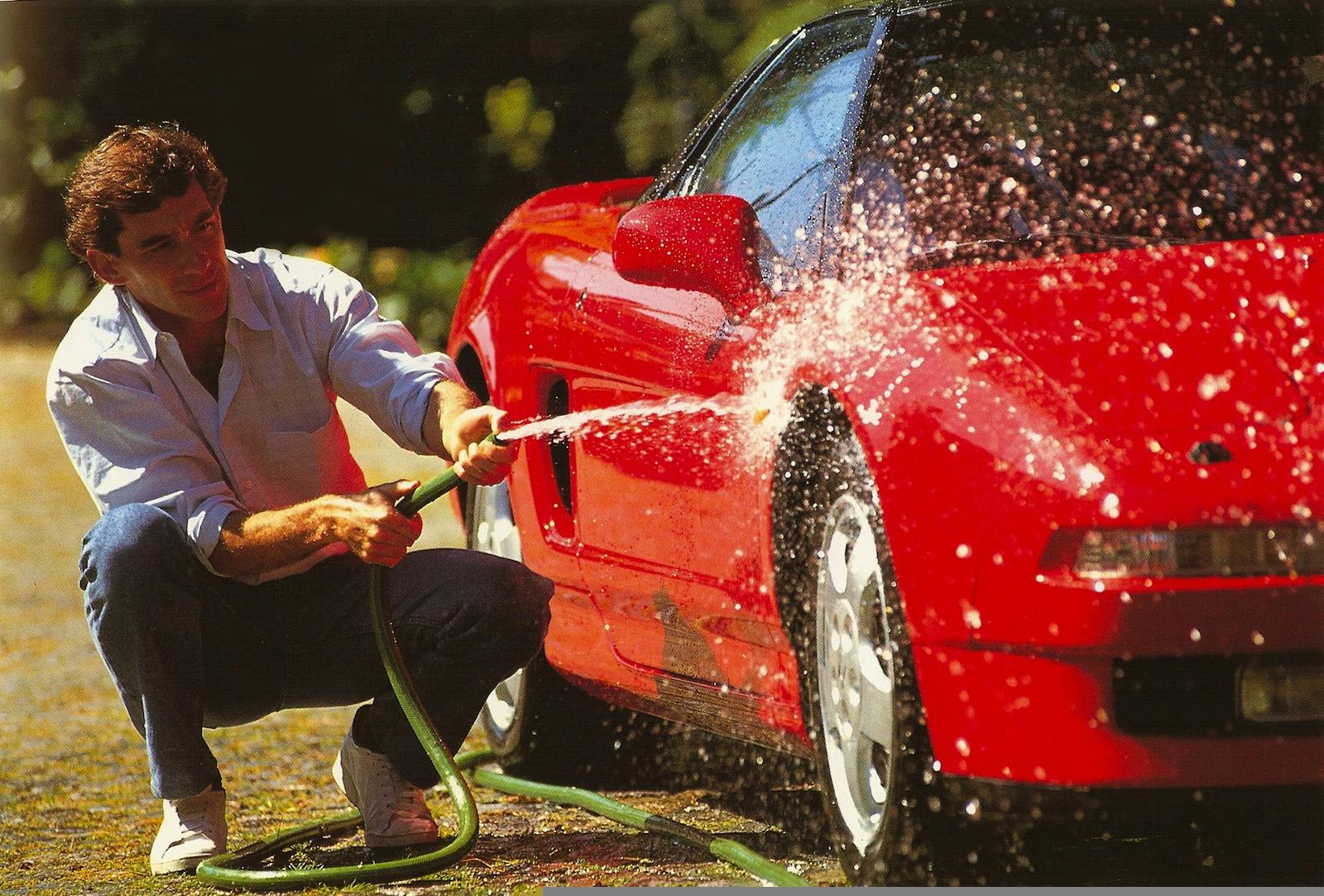Opinion: New Mustang is next verse, worse than the first
After much ado, the seventh-generation, 2024 Ford Mustang cometh. In the end, the rumors of hybridization, all-wheel drive, and the Explorer’s RWD/AWD platform were premature. The new Mustang, codename S650, remains pretty much business as usual. What it amounts to is more or less a mild, unremarkable evolution of the existing rear-drive architecture. But what does that mean for America’s pony car, and what might end up being this storied nameplate’s internal-combustion swan-song?
Ford is going all in on electrification as it reaps success from sticking batteries into the F-150 and leveraging the Mustang name to sell an electric crossover. For the moment, it appears to be happy to let the traditional Mustang wither on the vine … at least in the big-picture sense. Lest we forget, the Mustang is now the only non-pickup, non-crossover Ford you can buy in the United States. Maybe Ford realized its competition, the Chevrolet Camaro and Dodge Challenger, are not much longer for this world and it wouldn’t take much to keep the Mustang on top in the muscle car game.

The bare minimum appears to have been just enough. There were rumors that Ford would bolt its new Mustang onto the Explorer platform (CD6), which would have allowed for more up-to-date powertrains, including a hybrid setup. Historically, it should be mentioned, both the Mustang and the Camaro have kept up with prevailing technological and aesthetic trends. Both nameplates, for example, added a turbocharged four-cylinder model as a base engine in their most recent generations, but the Challenger and the Mustang in particular have been stressing a more retro vibe since the mid-2000s. Now it appears to be running over the same old ground, albeit in a new wrapper.
Part of the long-term success of the Mustang, even through its lean years, was how it has adapted to the market of its moment. It started in the Sixties when the Mustang was born as a way to give the common man flash for not much cash. Soon, Ford proved its mettle with growly Shelbys and considerable motorsports success. The hangover from the Sixties was the crisis-ridden Seventies, but the Mustang endured the Malaise Era and stayed alive through some questionable baroque styling and not much performance. Still, it was a reinvention that was correct for where the market was at the time.
When the Eighties arrived, the Mustang found itself with a hatchback and more considered Euro-style appearance, but again the pony car held true to making the best of its humdrum undercarriage with up-to-the-minute looks and features. (The Camaro marched in lockstep and did the same.)

Now for the full disclosure: Remember my old ’71 Duster, which I’ve mentioned in previous articles? When I realized that keeping such a highly strung beast on the road was out of my depth, I traded it for a Fox-body. Its motor was a boat-anchor 3.3 and it had a weird manual shift layout with an overdrive. I wired in my Sony CD changer wrongly, which left me to choose between headlights or music—not both at the same time. (This led to a rather interesting night out at the cinema with a girl I’d promised to take out in my Mustang.) But it was a Mustang nonetheless, and I’ve always lusted after one of the last ’93 Cobras after reading about them in a road test with its competitors.
Ford dipped it toes into the retro pool with the SN95 generation in 1994, before awkwardly forcing straight lines onto the 1999 redesign. But when S197 appeared in 2005, chief designer J Mays—who made his name with retrofuturism—set the controls straight for 1964. His work on this design was not influenced (as many believed) by the Mustang Giugiaro concept which would not appear until 2006. I’ve mentioned before how I think the 2005 Mustang is a bit blocky and ungainly, needing a bit more finesse to really sail as a successful throwback in the same way as the Challenger does.

So that’s where we’ve been ever since, Ford like Dodge and Chevrolet deciding that the first versions of these pony cars are the definitive ones. Translation: this is what these cars are and this is how you will remember them. No new Fox-body or pop-up headlight Camaros, no reinvention to keep up with the times; we’re selling you nostalgia rather than a contemporary update of the muscle car formula. Can you imagine a manufacturer green-lighting something as bold as the F-body glass tailgate today? The accountants would be in fits. The Charger has shamelessly kept up its rubber-burning reputation, but as we’ve seen with the new Daytona SRT concept, at least Dodge are trying something new.
S650 is, deep down, a remix of a remix of the 1964 original. It leans heavily on the outgoing S550 Mustang, using essentially the same underpinnings. It’s got a slightly more chiseled appearance, but the reality is one of a very big facelift.
Tooling up for a car is expensive, and among the biggest investments—apart from the lights—is the body in white. It’s the fundamental structure, the actual skeleton on which the car is built. Looking at this new Mustang, you can see the bones are carry-over. Doing it this way allows Ford to update the sheet metal, but I’d argue they’ve merely made it worse. It’s all a bit more of an exaggeration on the existing theme, with bigger hips and a more aggressive down-the-road graphic up front.

The front light to fender is a critical visual relationship, and this is one of those areas where we’re talking about fractions of an inch. Ford lowered the headlights for 2023 and made them a bit messy by trying to replicate the three vertical tail lamps, and by continuing a straight line across the grille managed to give the car a frowning look. The previous Mustang avoided this because its grille shape was more pronounced, so you didn’t notice as much. The S650 feels like a rearranging of existing graphical elements to no great effect.
The Mustang has dropped the black infill panel between the tail lights, reducing some of the visual break-up at the back. Having something to lessen the visual impact of painted sheet metal is important, because too much can bodywork can look bland. Of course, fewer parts means less cost.

It seems strange that car that trades primarily on its driving experience and tactile fulfillment settles for large touchscreens in its interior, especially after the previous model made such a big deal of having a “cockpit” inspired by aircraft design. We’ve seen good and bad TFT implementations over the last few years, but this feels terribly misguided. Ergonomics aside, the whole thing appears incongruous and not really in keeping with the muscle car aesthetic. Mostly the same, but worse, is not what I’d call a recipe for long-term success. Like the Camaro, the Mustang is no longer evolving to keep up with the times but remixing an existing concept to ever decreasing returns.
Now, I can hear you all saying that I’m contradicting myself, and after all, didn’t I praise the Challenger for doing exactly that? Here’s the difference. The Challenger had one look, stuck to it, and was always a unique ownership proposition. It never chased trends. The Mustang, for better or worse, did. It remained current and was even adaptable enough to be a huge hit in Europe, so its failure to do so this time around disappoints me.
I’m glad I didn’t stay up to watch the reveal like I may have done in the past. Because other than that ’93 Cobra, what I really want is a ’71 Mach 1 on dog-dish steelies.
***
Adrian Clarke is a professional car designer, earning a degree in automotive design from Coventry University and a Masters in Vehicle Design from the Royal College of Art in London. He worked for several years at a major European OEM, and in the ’90s his daily driver in London was a 1979 Ford Thunderbird.



Love the Violent Femmes reference 🍺
Sound like the author is upset because the car didn’t become a crossover suv? For not being built on the explorer chassis? More engine options? First EV technology is a dying tech, F1 is doing away with its electrification program and switching to internal combustion tan on 0 emission bio fuels. And Ford knowing that actually kept up with car and market trends. Second all the engine options available from ford can be fitted to the mustang in the same way furs uses them in the F150 or in the explorer, your claim that the decision that ford took to not build the mustang in the explorer chassis would narrow engine choices, seems juvenile and misguided. I do agree with the mustang s650 doesn’t feel fresh or needed but now it will be the only American muscle car available and ford know this, so now the bar is the mustang, and having no competition can basically do what it wants and get away with it
You can get a lot of variation on a platform now, it’s not just about underlying sheetmetal. The Focus and Maverick share a platform for instance. A platform is a kit of parts and shared systems, rather than say a chassis like it would have been in the past. So it doesn’t follow using the Explorer platform would have turned it into a crossover.
The article nailed! It’s more of the same and what has changed, wasn’t for the better. Particularly, I hate this trend of adding screens for everything, specially when it gives the impression that the cockpit was removed and a tablet was added without any integration. A awd version would make it a practical vehicle for the winter and a mild hybrid option would improve acceleration and save a bit of gas…
The front redesign is nothing to write home about though I think it looks better than the 18′ changes. The best looking is still the original that came out in 2015. The changes on the back are horrible. Pretty happy with my 2015 GT PP!
I always reserve judgement on design until I see a car in metal, on the road, in the wild. Photos give me clues what details to spot, but really all the praising and trashing is way early for me.
Ford was/is in a bit of a no can lose/ no can win situation and I support the path they took. A Mustang has to look like one to sell to the faithful. Leave converting the tech/EV crowd to a different vehicle or another cycle.
Agreed, but I had to go with what I had and that was the press pack. I am usually a bit reluctant to do these kind of armchair crits without actually seeing the car, but this felt like an important one.
I like it, period!!!!!!
First time I’ve ever disagreed with you Adrian but I think they did a good enough job with it. Like it or not, nostalgia sells and many of us are grasping for heydays anywhere we can. But I’m with you on the touchscreen issue, and right with you on the ’71 Mach 1. Long Live Nostalgia!
Hey, it would be dull if we all liked the same thing right? I don’t think it’s necessarily an ugly car per se, just a bit rigid and aggressive without good reason. It feels a bit disjointed visually, but I wouldn’t turn one down at the rental counter. I am just a bit disappointed Ford didn’t do more.
The Mustang went from an affordable sporty car to an expensive sporty car.
Someone call Congress, this is a total abortion. Why not just kill the Mustang right now rather than let it die a slow agonizing death. From the atrocious head lights to the wing on the trunk, it is a styling nightmare. And the interior looks like it should be a Chrysler K car. What designer would desecrate one of the most beloved pieces of auto artwork with a car like this. I have had Mustangs all my driving life ( a’65 notch back, a’67 notch back, a ’72 hardtop, a ’96 GT convert, a 2015 GT convert and a 2020 GT convert) and believe the 2020 GT convert I have right now will be the last. Sorry to see a legend die like this.
I had a 69 Mach 1 428 I loved this car and wish I could afford the 69 again.
Watch out for the 2024, it looks like a real winner.
The Mustang will have the market segment all to themselves with the demise of the Camaro and the Charger, so maintaining the same formula doesn’t seem like a mistake. Back when front wheel drive was the rage, what was supposed to be an updated Mustang became a different car altogether in the Probe because of the backlash. I don’t think Ford wanted to make the same mistake and alienate the Mustang’s loyal following by going away from a proven formula. I don’t think I’m in the minority in finding cars that are bucking future trends more compelling. They’ll have plenty of time for hybrids, awd platform sharing and the like. Long live the Mustang!
Am I alone in thinking that this Mustang and the Camaro are just completely similar in appearance?
That was my first thought.
My exact comments to a friend a few days ago, “Looks good from the back, but don’t like the front. The dark gray looks a lot like a Camaro…”
The have very similar themes in that they are becoming squashed aggressive caricatures with each update, to the detriment of good visiblity and timeless looks.
I own a 69 Mustang, had a 2005, have considered 2012ish for some time (not as fussy on the since-then).
This new one doesn’t really do anything for me. Yes it will capture some Chev/Dodge that want old school but it will lose some because of the tablet dashboard-more-appliance-less-racecar.
I’m personally not particularly interested in paying more for the hybrid privilege but also live somewhere where that might be my only option very soon (or pure EV). Adding the hybrid OPTION isn’t going to hurt sales, but it could win some.
AWD is a game changer. As an OPTION it would make a Mustang viable for me as a year-round commuter. I’d even tolerate the meh looks and iPad-life interior. I think this is a huge lost opportunity of sales and larger market share.
If you want Mustangs to continue… more market share with cars that actually look like Mustangs would be a good thing, whether they are optioned to your own preference doesn’t matter.
I’m glad it exists as a RWD coupe with V8 power but I am not really a fan of what they did to it exterior wise or the interior wall of screens.
In this crazy world, I think it’s nice to have this retro vehicle still in the lineup. I’m still sad Ford no longer makes a sedan for the masses. The fact is Americans have been too eager to buy foreign nameplates so that is the reality now. If you want a sedan, you now HAVE to buy a foreign nameplate. I have always bought American nameplate vehicles the 45 years I have been driving (almost all Ford/Mercury) You can call me old school or old fashioned or whatever you want but I’m proud to have done so. I am sure many will go on about country of origin parts content, etc. etc. but if Americans put American companies first the last 50 years, we would not have foreign nameplates owning more than half our market. Europe and Japan have been much smarter regarding their own automotive markets than we ever have. P.S. I have never been stranded in case you want to throw out the quality argument.